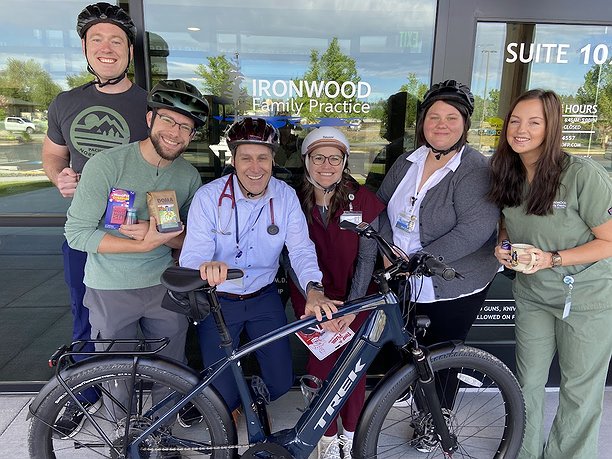E-biking to work with Dr. Walsworth (and friends)
Following my column from last fall when I walked to work with Dr. Walsworth, I am often asked by patients if I am still walking to work. The truth is that I have not been keeping up with walking to work regularly, and since Ironwood Family Practice moved to our new location on Schreiber Way in February, it is now a bit too far to walk to work.
My ever-dedicated colleague, Dr. Walsworth, however, switched to e-biking to work once we moved and has kept it up (in all sorts of weather!) so I decided to join him once again, this time on an e-bike.
Never having e-biked, however, I first met with the wonderful folks at the Trek Bicycle Store on Fourth Street in Coeur d’Alene to learn more. John Tindall gave me a crash-course on everything e-bike and owner Carrie Martin even loaned me her husband’s bike for the ride to work.
I learned there are all sorts of e-bikes just like there are different bicycles to meet your specific needs. Mountain e-bikes are made for tackling the most aggressive trails and remote locations. Trail bikes have less travel on the shocks than mountain bikes (and are a bit lighter) and are great for easier trails and riding on gravel roads. Hybrid/commuting bikes have smaller tires and a more upright configuration so they’re easier on the neck and back. Cruiser bikes are built for comfort and are great for going out for coffee and are also more affordable.
Speaking of cost, several factors affect how much you might spend, including class of e-bike, range and battery type. There are three classes of e-bikes. Class 1 e-bikes are assist-only (meaning you have to pedal for the motor to engage) but max out at 20 mph. Class 2 e-bikes have a throttle so you theoretically don’t even need to pedal. Class 3 e-bikes are assist-only and go up to 28 mph with assistance.
Extended range, such as 150-160 minutes versus 100-110 minutes costs more, although it’s a little hard to pin down exact ranges because there are four assist modes including Eco, Tour, Sport and Turbo which affects range from around 60 miles down to around 20 miles depending on what mode you’re using.
Another differentiator is built-in versus removable battery. E-bikes with removable batteries are generally more expensive because the battery can be stored indoors to avoid exposing it to temperature extremes, which are hard on batteries. Plus, if it’s removable, you can keep an extra battery if you want to do hardcore downhill mountain biking for a whole day.
When I asked John whether e-biking is “cheating” by not having to pedal as hard, he assured me that you can still get a good workout and it opens up new possibilities like riding with people of different abilities and “you don’t have to be so full of energy to tackle hills or longer distances.” In fact, research shows that people ride e-bikes more often and farther, so they get more physical activity, even though it’s less intense. One Dutch study has reported that individuals in the Netherlands commuted 50% farther with an e-bike than on a conventional bike.
The day Dr. Walsworth and I e-biked to work, May 17, the weather was cool and breezy in the morning but warmed up nicely by afternoon. We zoomed along on our e-bikes, chatting the whole way. It also happened to be National Bike-to-Work Day, so we encouraged everyone at Ironwood Family Practice to get in on the fun and bike to work that day. Doma Coffee even sponsored us with free coffee! Arriving at work I felt invigorated and, best of all, because of the e-bikes I didn’t need a shower.
THE GOOD: E-biking is inclusive, allowing people of all ages and fitness levels to enjoy bicycling. Batteries last 15,000 to 20,000 miles before they wear out (and the Trek Store also has a recycling program).
THE BAD: The cost of an e-bike can vary from less than $1,000 to more than $10,000. Also, regulations differ from state to state about what roads and trails e-bikers can use.
THE NITTY GRITTY: Although e-biking is less intense exercise (you burn about 30% fewer calories than on road bikes) it allows more people to bike to work and is tons of fun.
• • •
Dr. Emry is a family physician and partner at Ironwood Family Practice in Coeur d’Alene. Exercise Explorer MD will appear every other week in The Press and Dr. Emry can be contacted via email exercisexplorermd@gmail.com. © 2024. This work is licensed under a CC BY-ND 4.0 license.



